 Iran’s Attack on Israel
Iran’s Attack on Israel
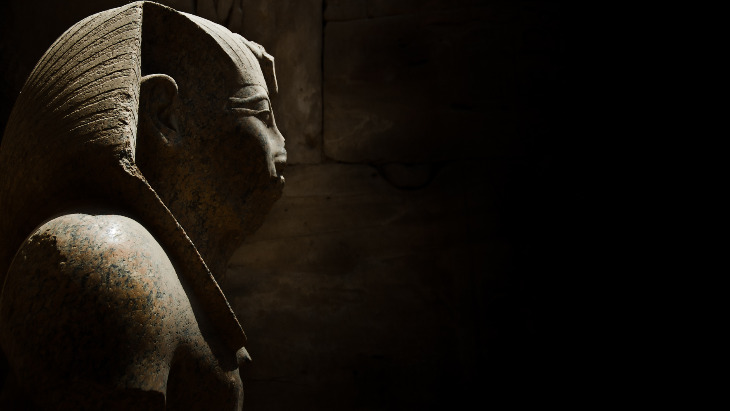

19 min read
Is there archaeological evidence that supports the Bible?
Read Part One: Archaeology and the Exodus
"Good scholars, honest scholars, will continue to differ about the interpretations of archaeological remains simply because archaeology is not a science, it is an art. And sometimes it is not even a very good art."
- William Dever, Professor of Near Eastern Archaeology and Anthropology, University of Arizona
An artist manipulates given materials, determining what the final product will look like. Dever, one of the most highly respected voices in his field, is not referring to the manner in which archaeological remains are retrieved, but rather to the manner in which one interprets the significance of those remains.
When it comes to interpretation of remains from the time and place of the Bible, the radical "differences" in interpretive style seem more like the art of war than the art of culture. For example, here are the infamous words that launched the most recent battle concerning archaeology and the Bible:
"This is what archaeologists have learned from their excavations in the Land of Israel: The Israelites were never in Egypt, did not conquer the land in a military campaign and did not pass it on to the 12 tribes of Israel."
- Ze'ev Herzog, Professor of Archaeology and Ancient Near Eastern Studies, Tel Aviv University
Herzog, along with other archaeologists, are considered biblical minimalists (or revisionists as Dever calls them) who see very little historical value in the Bible. Revisionists, like Herzog and Prof. Israel Finkelstein have attempted to speak in a bombastic fashion on behalf of the entire school of biblical archaeology. They are so convinced of their position that they ignore any other approach that does not concur with their own.
If anything gets Dever's blood boiling it is when revisionists distort archaeology, thus cheapening and mocking the integrity of his entire academic field.
Revisionists stubbornly dismiss as fictitious most historical aspects of the Bible. To them, the patriarchal period (Abraham, Isaac and Jacob) is all imagination, the story of Joseph and the sojourn in Egypt is fabricated, as are the Exodus and the desert wanderings. The conquest, settlement and united monarchy (Saul, David and Solomon) are mere "propaganda" to quote Philip Davies. Marit Skjeggestad, a Scandinavian revisionist, said that on biblical history, "the archaeological record is silent."
"In fact," asserts Dever, "the archaeological record is not at all silent. It's only that some historians are deaf."
So let's turn to the evidence.
Patriarchal Period
One of the assumptions of Bible criticism is that the Bible was written much later than the time period it occurred. Specifically, the claim is that the Bible was written at least 1,000 years after the Exodus. As a result, the alleged biblical writers, who could not possibly know the minutiae of cultural norms of 1,000 years before, would by default include many details that were anachronistic. This would be like watching a movie about life in the 1950s where the actors wore digital watches because the writers did not do their research properly.
All this changed with the turn of a shovel.
One of the main indications of an anachronism in the Bible was thought to be that of the camel. The Book of Genesis reports that camels were mainstay beasts of burden and transportation already at the time of Abraham, in the 18th century BCE. Yet it was originally thought that camels were first domesticated in the Middle East no earlier than the 12th century BCE. This anachronism was a clear indication of the later writing of the Bible. Or so it was thought.
All this changed with the turn of a shovel. Recent archaeological finds have clearly demonstrated that the camel was domesticated by the 18th century BCE. What was previously thought to be a knockout punch against the Bible, is now evidence supporting it.
Prof. Kenneth Kitchen, an Egyptologist at the University of Liverpool (retired) points out that the sale of Joseph to a caravan of Midianites (for 20 silver pieces) could have been an example of anachronism in the Bible, since 1,000 years later the price for a slave was much higher (ancient inflation). However, the price reported in the Bible matches precisely the going price of slaves in the region from Joseph's time period. This is just one example that demonstrates, according to Kitchen, that "it's more reasonable to assume that the biblical data reflect reality."
Furthermore, we find that the detailed descriptions of the court of the Pharaoh and its protocols, as reported in Genesis, are extremely accurate to that time period. Joseph's Egyptian name, clothing, and court orders are all very much in line with what we now understand to have been the norm for that time and place.
Sojourn in Egypt
What about evidence of Jewish slavery?
Egyptologist Sir Alan Gardiner said of Egyptian archaeology: "It must never be forgotten that we are dealing with a civilization thousands of years old and one of which only tiny remnants have survived. What is proudly advertised as Egyptian history is merely a collection of rags and tatters."
This sketchy archaeological record makes a document preserved from the Israelite slavery period even more astounding. Known as the Brooklyn Papyrus (because it is in the Brooklyn Museum), this document portrays Israelite names from the Bible as the names of domestic slaves: Asher, Yissachar, and Shifra. The document also includes the term "hapiru" which many scholars agree has clear historical affinity to the biblical term "ivrim," meaning "Hebrews."
The Bible records that Jews built the storage cities of Pitom and Ramses. Austrian archaeologist Manfred Bietak has succeeded in positively identifying the city of Pi-Ramesse. This city he found dates exactly to the period of the sojourn in Egypt, and even contains many Asiatic (of Canaanite origin) remains at the area of the slave residences.
Egyptian records also tell how Pharaoh Rameses II built a new capital called Pi-Ramesse (the House of Rameses) on the eastern Nile delta, near the ancient area known as Goshen, the precise geographic area where the Bible places the Israelites.
Further, the Leiden Papyrus (another Egyptian document of that era) reports that an official for the construction of Ramasses II ordered to "distribute grain rations to the soldiers and to the Apiru who transport stones to the great pylon of Ramasses." (Apiru, as we said, is related to Hebrews.)
Professor Abraham Malamat of Hebrew University infers from this that the Hebrews were forced to build the city of Ramasses. "This evidence is circumstantial at best," notes Malamat, "but it's as much as a historian can argue."
Exodus and Desert Wandering
"When Pharaoh let the people go, God did not lead them by way of the land Philistines, although that was near; For God said: "Lest the people repent when they see war and return to Egypt." (Exodus 13:17)
Prof. Malamat explains the reason for this detour: At that time in Egyptian history, and lasting for only about 200 years, there was a massive, nearly impenetrable network of fortresses situated along the northern Sinai coastal route to Canaan. Yet these same defenses were absent near Egypt's access to southern Sinai ― because the Egyptians felt the southern route was certain death in the desert.
Therefore, when Moses tells the Israelites to encamp at a site that will mislead Pharaoh, the Egyptians will conclude that the Israelites "are entangled in the land, the wilderness has closed in on them" (Exodus 14:3). This, according to Malamat, "reflects a distinctly Egyptian viewpoint that must have been common at the time: In view of the fortresses on the northern coast, anyone seeking to flee Egypt would necessarily make a detour south into the desert, where they might well perish."
More evidence comes from an ancient victory monument called the "Elephantine Stele." Here is recorded a rebellion in which a renegade Egyptian faction bribed Asiatics living in Egypt to assist them. Although the rebellion ultimately failed, it does confirm that in the same time period when the Israelites were in Egypt, the Egyptians would very likely say, "Come let us deal wisely with them, for if war befalls us, they may join our enemies and fight against us and escape from the land" (Exodus 1:10). "That is precisely what happened in the episode recorded in the Elephantine Stele," Malamat asserts.
Biblical criticism comes from the late archaeologist Gosta Ahlstrom. He declares: "It is quite clear that the biblical writers knew nothing about events in Palestine before the 10th century BCE, and they certainly didn't know anything of the geography of Palestine in the Late Bronze age," the time of the desert wandering and subsequent conquest of the land of Canaan. Ahlstrom's proof? He cites the biblical listing of cities along the alleged route that the Israelites traveled immediately before reaching the Jordan River ― Iyyim, Divon, Almon-divlatayim, Nevo, and Avel Shittim (Numbers 33:45-50), and reports that most of these locations have not been located, and those that were excavated did not exist at the time the Bible reports.
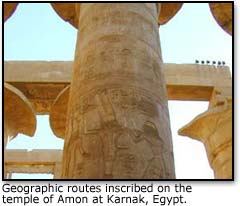 In the meantime, writings from the walls of Egyptian Temples say differently. It is well known that Egypt had much reason to travel to Canaan in those days; trade, exploitation, military conquest. These routes are recorded in three different Egyptian Temples ― listed in the same order as provided in the Bible, and dated to the exact period of the Israelite conquest of Canaan.
In the meantime, writings from the walls of Egyptian Temples say differently. It is well known that Egypt had much reason to travel to Canaan in those days; trade, exploitation, military conquest. These routes are recorded in three different Egyptian Temples ― listed in the same order as provided in the Bible, and dated to the exact period of the Israelite conquest of Canaan.
Another piece of outside verification is an ancient inscription housed in the Amman Museum. Dating to the 8th century BCE (at least), it was found in the Jordanian village of Deir Alla, which was Moabite territory in biblical times. This inscription tells of a person by the name of Bilaam ben Beor, known to the locals as a prophet who would receive his prophecies at night. These features match precisely the Bilaam described in the Bible (Numbers 21) ― his full name, occupation, nighttime prophecies. And of course, Bilaam was a Moabite.
From Which Perspective?
The biblical story of the Exodus is filled with divine intervention in the form of impressive miracles; the splitting of the sea, the revelation at Mount Sinai, the manna bread which fell from heaven, etc. In the opinion of Bible critics, the story is nonrealistic because there is little record of mass encampments from that time, and it is absurd to consider that the Israelites had provisions in the desert for such a huge population and for such a long period of time.
Not always fitting the academic view, is no indictment of the Bible.
However, this opinion needs to be viewed in its proper perspective. It is not the Bible that the archaeologists are impugning, rather they find inconsistencies with their own reconstructed version! The Bible clearly states that the Israelites' food, clothing, and protection was provided directly by God. That the Bible does not always fit the academic reconstituted view, does not constitute an indictment of the Bible.
As for the issue of encampments are concerned, it is nearly impossible to find traces of large Bedouin encampments in the Sinai Desert from 200-300 years ago. So would one expect the remains of large encampments after 3,000 years?
Conquest of Canaan
Through the 1980s it was commonly held opinion that excavations in Jericho had failed to discover a city there at the time of Joshua.
In the early 1990s, however, Dr. Bryant G. Woods, then of the University of Toronto, reported finding startling remnants of Jericho in Joshua's time. The error of previous excavations, he asserts, was that archaeologists were digging in the wrong section of the mound of ancient Jericho.
Woods reported finding a 3-foot layer of ash covering the entire excavated area, clear evidence of destruction by fire. He further discovered large caches of wheat from the spring harvest that had barely been used. This means that the city fell not as a result of a starvation siege, as would be expected against a walled city, but rather after a very brief siege. All this matches the account in the Book of Joshua. Furthermore, the wheat was from the spring harvest; Joshua conquered Jericho immediately after Passover, the spring holiday.
Concerning Woods' work at Jericho, Dr. Lawrence Stager, the respected professor of Archaeology in Israel from Harvard University said: "On the whole the archaeological assessment is not unreasonable. There is evidence of destruction and the date isn't too far wrong."
Rarely can an archaeologist claim that "this is the very item the Bible spoke about." Yet Dr. Adam Zartal, chairman of the Department of Archaeology at the University of Haifa, may have done it. Joshua 8:30-35 tells of the fulfillment of Moses' command to build an altar on Mount Eval (Deut. 27). Zartal reports that his excavation team found this very altar. The place is right, the time is right, and the animal bones are consistent with the biblical offerings. Even the style of the altar is right, in such detail, says Zartal, that it looks nearly identical to the description of the Temple's altar as described in the Talmud ― a uniquely Israelite design that no Canaanite temples used then or later.
"Silence has descended on the scholarly world."
Zartal laments the response of the revisionist archaeological community. "What happened regarding the new accumulation of facts I have cited? Almost nothing. Since the appearance of the detailed report and the many articles I have published on the excavation... silence has descended on the scholarly world."
Regarding Zartal's find, Dr. Lawrence Stager said: "If a sacrificial altar stood on Mount Eval, its impact on our research is revolutionary. All of us [biblical archaeologists] have to go back to kindergarten."
Still Adamant
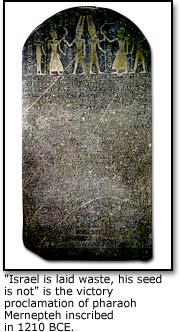
Revisionists insist there was no such entity as "Israel" until at least the 9th century BCE. Yet a well known Egyptian inscription dated to about 1210 BCE clearly identifies an Israel in the land of Canaan as a people that had to be reckoned with. The inscription, which depicts the victories of Pharaoh Merneptah in Canaan, reads in part: "Israel is laid waste, his seed is no more."
How do revisionists react to this inscription? Dismissively. Says Dever: "They denigrate it as our only known reference. But one unimpeachable witness in the court of history is sufficient. There does exist in Canaan a people calling themselves Israel, who are thus called Israel by the Egyptians ― who after all are hardly biblically biased, and who cannot have invented such a specific and unique people for their own propaganda purposes."
More: In the book of Samuel, the Philistines are reported to be expert metal workers, and in the Book of Jeremiah they are reported to have originated in Crete. Both of these details concerning the Philistines, who were off the political map by the 9th century BCE, are corroborated through archaeology.
Furthermore, 1-Samuel 13:19-21 records the Israelites relying on the metal smiths of the Philistines, and a 'pym' used in the tool-sharpening process. But what this 'pym' was has been a mystery. Recent excavations found that an ancient coin weight called a "pym," which was used exclusively during the Israelite settlement period, was apparently the payment for the service of sharpening. Posits Dever: "Is it possible that a writer in the 2nd century BCE could have known of the existence of these pym weights which... would have disappeared for 5 centuries before his time? It is not possible."
Additionally, in the hill regions of Judea and Samaria (the heartland of ancient Israel), approximately 300 small agricultural villages were found, built between the 13-11th centuries BCE, the time period of the Israelite conquest of the land. According to Dever, this represented a large population increase that did not come from the native population. He writes, “Such a dramatic population increase cannot be accounted for by natural increase alone, much less by positing small groups of pastoral nomads settling down. Large numbers of people must have migrated here from somewhere else, strongly motivated to colonize an under populated fringe area of urban Canaan now in decline at the end of the Late Bronze Age.” Also, the type of house structure was unique, and matched descriptions in the books of Judges and Samuel. Additionally, all of the settlements lacked any pig remnants amongst animal bones left in the area; only the Jews had a pigless diet.
David and Solomon
Some archaeological revisionists thought they'd dealt a harsh blow to the ego of Israeli nationalism and Jewish pride when they declared the united monarchy of David and Solomon "fictitious propaganda of the ancient biblical writers."
Let's see the evidence.
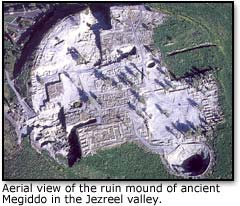 The Bible relates how King Solomon renovated three cities ― Chatzor, Megiddo and Gezer ― to serve as garrisons for his cavalry. Archaeologists have discovered identically designed gates to these cities that date to the time of Solomon. Noted Israeli archaeologist Amihai Mazar wrote: "The city gates of Megiddo, Hazor, and Gezer were... bold illustration of a centralized, royal building operation attributable to Solomon on archaeological grounds as well as on the basis of the biblical reference."
The Bible relates how King Solomon renovated three cities ― Chatzor, Megiddo and Gezer ― to serve as garrisons for his cavalry. Archaeologists have discovered identically designed gates to these cities that date to the time of Solomon. Noted Israeli archaeologist Amihai Mazar wrote: "The city gates of Megiddo, Hazor, and Gezer were... bold illustration of a centralized, royal building operation attributable to Solomon on archaeological grounds as well as on the basis of the biblical reference."
Prof. Israel Finkelstein, a revisionist, theorized a different dating system that places the construction of the gates 100 years after the time of Solomon. Yet, says Dever, this new dating system "is not supported in print by a single other ranking archaeologist."
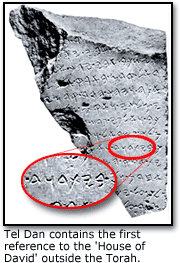 Further evidence exists of David and Solomon, known biblically as the "founders of the House of David" (referring to the dynasty of kings beginning with David). In northern Israel, at the ancient Tel Dan, archaeologist Avraham Biran discovered a victory inscription dated to the 9th century BCE. A neighboring king, in describing his victories over Israel, writes in unambiguous terms the phrases, "King of Israel" and "Beit David" (House of David).
Further evidence exists of David and Solomon, known biblically as the "founders of the House of David" (referring to the dynasty of kings beginning with David). In northern Israel, at the ancient Tel Dan, archaeologist Avraham Biran discovered a victory inscription dated to the 9th century BCE. A neighboring king, in describing his victories over Israel, writes in unambiguous terms the phrases, "King of Israel" and "Beit David" (House of David).
Additionally, another inscription of a foreign victory over Israel is the Mesha or Moabite Stone, dated to the 9th century BCE, and now housed in the Louvre Museum in France. French scholar Andre Lemair studied the inscription and concluded that the phrase "House of David" appears there also.
Ardent revisionist Dr. Philip Davies strove valiantly to claim that the readings are ambiguous. However, in the words of Anson Rainey:
"As someone who studies ancient inscriptions in the original, I have a responsibility to warn the lay audience that the new fad (revisionism) represented by Philip Davies and his ilk is merely a circle of dilettantes. Their view that nothing in the biblical tradition is earlier than the Persian period, especially their denial of the existence of the united monarchy, is a figment of their vain imagination. The name 'House of David' in the Tel Dan and Mesha inscriptions sounds the death knell to their specious conceit. Biblical scholarship and instruction should completely ignore the (revisionist) school. They have nothing to teach us."
Davies' evasive maneuver was also too much for Dever. He said that this "is an example of the lengths to which scholars will go to avoid the obvious when it does not suit them." It should be noted that the Tel Dan inscription was found shortly after Davies had just published his major revisionist work on the nonexistence of King David and the united monarchy.
Revisionists have also argued against King David's conquest of Jerusalem and Solomon's major building in the city, due to the lack of archaeological remains from that time period.
"Determined to unmask the ideology of others, they have become ideologues themselves."
Archaeologist Jane Cahill explains the missing structures. In ancient Jerusalem, because of its narrow ridges and steep hills, one does not build on top of the remains of a preexisting structure, as one would do on flat land. Rather it is necessary to completely disassemble the previous building down to bedrock, in order to get a firm foundation and start again. Jerusalem was also heavily quarried by the Romans and Byzantines. This "means only that the archaeological record has not been sufficiently preserved," asserts Cahill.
Meanwhile, archaeologists Ronny Reich and Eli Shukron have unearthed the remains of a defensive wall in Jerusalem that predates King David. They also found a small number of towers which protected the Gihon spring water supply, dating to the time of Abraham.
Conclusion
Dever sums up the attitude of objective scholars:
"In my view, most of the revisionists are no longer honest scholars, weighing all the evidence, attempting to be objective and fair-minded historians, seeking the truth. Determined to unmask the ideology of others, they have become ideologues themselves. The revisionist and the postmoderns are dangerous because they have created a kind of relativism ― an anything goes attitude ― that makes serious, critical inquiry difficult if not impossible."
So where do we stand?
Prof. Adam Zartal, chairman of the Dept. of Archaeology at the University of Haifa has this to say about archaeology and the Bible:
After years of research, however, I believe it is impossible to explore Israel's origins without the Bible. At the same time, the research should be as objective as possible. The Bible should be used cautiously and critically. But again and again we have seen the historical value of the BIble. Again and again we have seen that an accurate memory has been preserved in its transmuted narratives, waiting to be unearthed and exposed by archaeological fieldwork and critical mind work.
Let my people know.
Further Reading:
